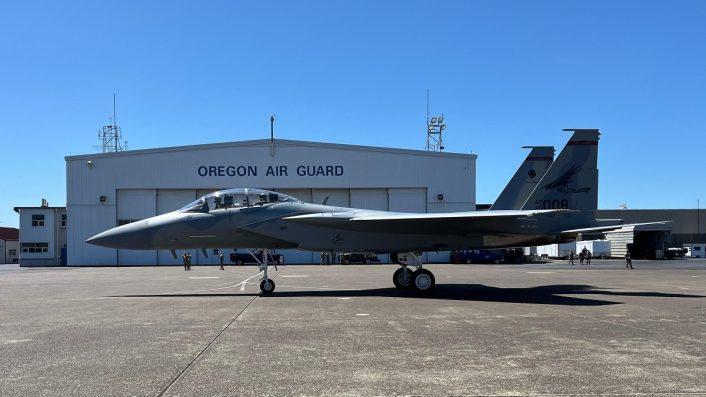The new aircraft, which is set to replace the aging F-15C/D Eagle, will be assigned to the 142nd Wing at Portland Air National Guard base.
The first F-15EX Eagle II has been delivered to an operational unit, the 142nd Wing of the Oregon Air National Guard, on June 6, 2024. The aircraft, 20-0008, is the first of 18 that will arrive to Portland Air National Guard Base in the following years.
Before delivery, the aircraft has received the tail flash and insignia of the 123rd Fighter Squadron and the Oregon ANG.
A video shared by Boeing shows that 20-0007, which will be delivered in the next two weeks, received full color tail flash, while 20-0008 received a subdued variant.
Tails painted — all dressed up for delivery.#F15EX EX7 and EX8 get the final touches before they head to their new home with the @142ndWG, home to @OregonGuard‘s Redhawks. pic.twitter.com/UJ7KcFcJec
— Boeing Defense (@BoeingDefense) June 6, 2024
The delivery of the first Eagle II to the Oregon ANG represents the first time a new weapon system is delivered to the Air National Guard before serving in the Air Force. So far, six F-15EXs have been delivered to Eglin Air Force Base, Florida, where they are supporting developmental and operational tests on the new aircraft, while Portland is receiving the first operational examples.
The Air Force has previously said five F-15C instructor pilots from the 123rd FS conducted training in the F-15EX with instructors from the 85th Test and Evaluation Squadron at Eglin A.F.B. in March. After the first flights, the pilots said they are impressed by the new aircraft, which closely resembles its C-model predecessor externally but it’s entirely different and much improved internally and will inevitably take some getting used to.
EX8 looking great!
The first combat-ready #F15EX Eagle II heads to its new home with the @142ndWG.
Up next ➡️ EX7. pic.twitter.com/OY1Vyh6Y5t
— Boeing Defense (@BoeingDefense) June 7, 2024
The delivery of the next F-15EX will mark the completion of the delivery of Lot 1B and will avoid a schedule breach by Boeing. The U.S. Air Force has previously mentioned that the program was not at risk of a schedule breach as long as Boeing delivered this lot of aircraft to the service by the end of this month.
The F-15EX Eagle II
The new F-15EX, developed from the F-15QA that was the most advanced Eagle variant, comes from a series of needs mainly emerged after the National Defense Strategy directed the U.S. armed services to adapt to the new threats from China and Russia. The aircraft, while extremely similar to the QA variant, features some US-only capabilities like the new AN/ALQ-250 Eagle Passive Active Warning Survivability System (EPAWSS) electronic warfare and electronic surveillance system and Open Mission Systems (OMS) architecture.
Initially the F-15C/D fleet was to be entirely replaced by the F-22A Raptor, the first 5th gen fighter aircraft of the U.S. Air Force. The service planned to buy 750 Raptors to replace both the F-15 Eagle and the F-16 Fighting Falcon, but that number was cut to 187 production aircraft, which is also less than the about 230 F-15C/D still in service. Because of this, the operational life of the Eagle had to be extended as it was initially scheduled to be retired in 2019.

When the F-15X program, also known as Advanced F-15, was first launched, both a single and two seat variants were proposed, called F-15CX and F-15EX respectively, and both with the same exact capabilities. The Air Force ultimately decided to go only with the two seats variant, which will reportedly have the option to fly with a single pilot or both pilot and Weapons Systems Officer (WSO).
The Eagle II completed last year the Integrated Test & Evaluation (IT&E) Phase I, during which the F-15EX participated in 19 Large Force Exercise events where it integrated with 5th generation aircraft, recorded the longest Air-to-Air Missile employment, and validated the first F-15EX employment of the longest non-nuclear Air-to-Ground munition release in the inventory.
While the initial Phase I testing was conducted with CFTs, the test data produced is representative of the production aircraft equipped with two external tanks, said the Director, Operational Test & Evaluation report. The lack of CFTs, however, will limit the number of external pods and air-to-ground weapons the F-15EX will be able to employ. The report also mentioned Phase II, which consisted of five four-ship missions, was cancelled due to already having sufficient data to complete an assessment to support the full-rate production (FRP) decision.
The service initially planned to acquire up to 144 F-15EX aircraft, however the number decreased to 104 last year. Now the number was reduced even more, with the FY 2025 budget request mentioning the Air Force will buy the last aircraft in 2025 and then end the production, capping the fleet at 98 aircraft.









